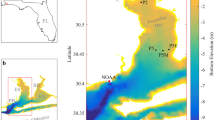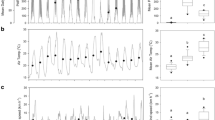Abstract
Although diel dissolved oxygen curves in aquatic ecosystems usually have a unimodal shape, occasionally bimodal curves are observed. Examples of bimodal curves are found throughout literature for various types of aquatic systems; nevertheless, the phenomenon has been generally ignored. In the present study diel changes in dissolved oxygen, temperature, and irradiation were continuously monitored over a 2 year period in an artificial pond. Through analysis of variance an attempt was made to isolate the physical circumstances under which bimodal oxygen curves can be expected. It is suggested that a persistent high irradiation level and/or its accessory high rate of temperature increase and/or a usually simultaneous high rate of primary production may induce bimodal oxygen curves. However, a conclusive explanation could not be given.
Similar content being viewed by others
References
Edwards, R. W. & M. Owens, 1962. The effects of plants on river conditions: IV. The oxygen balance of a chalk stream. J. Ecol. 50: 207–220.
Ganning, B. & F. Wulff, 1970. Measurements of community metabolism in some Baltic brackish water rockpools by means of diel oxygen curves. Oikos 21: 292–298.
Harris, G. P., 1978. Photosynthesis, productivity and growth: The physiological ecology of phytoplankton. Arch. Hydrobiol. Beih. 10: 171 pp.
Hodges, J. D., 1967. Patterns of photosynthesis under natural environmental conditions. Ecology 48: 234–242.
Hunding, C., 1973. Diel variation in oxygen production and uptake in a microbenthic littoral community of a nutrient-poor lake. Oikos 24: 352–360.
Kalbe, L., 1972. Sauerstoff und Primärproduktion in hypertrophen Flachseen des Havelgebietes. Int. Rev. ges. Hydrobiol. 67: 825–862.
Kelly, M. G., G. M. Hornberger & B. J. Cosby, 1974. Continuous automated measurement of rates of photosynthesis and respiration in an undisturbed river community. Limnol. Oceanogr. 19: 305–312.
Lingeman, R., 1980. Signal analysis of irradiation, temperature and primary production in a small artificial pond: I. The annual signals. Int. Rev. ges. Hydrobiol. in press.
Odum, H. T., 1956. Primary production in flowing waters. Limnol. Oceanogr. 1: 102–117.
Odum, H. T. & C. M. Hoskin. Comparative studies on the metabolism of marine waters. Publ. Inst. Mar. Sci. Univ. Texas 5: 16–46.
Sokal, R. R. & F. J. Rohlf, 1969. Biometry. W. H. Freeman and Co. San Francisco, 776 pp.
Stross, R. G., S. W. Chisholm & T. A. Downing, 1973. Causes of daily rhythms in photosynthetic rates of phytoplankton. Biol. Bull. 145: 200–209.
Uhlmann, D., F. Cramer & E. Arndt, 1974. Step-forcing of laboratoryscale aquatic ecosystems as a means to test their response and stability. Dep. Water Res. Dresden (DDR) and Biol. Dep. Rostock (DDR), unpublished report, 7 pp.
Author information
Authors and Affiliations
Rights and permissions
About this article
Cite this article
Lingeman, R., Ruardij, P. On the occurrence of bimodal diel dissolved oxygen curves in aquatic systems. Hydrobiologia 78, 267–272 (1981). https://doi.org/10.1007/BF00008523
Received:
Issue Date:
DOI: https://doi.org/10.1007/BF00008523




